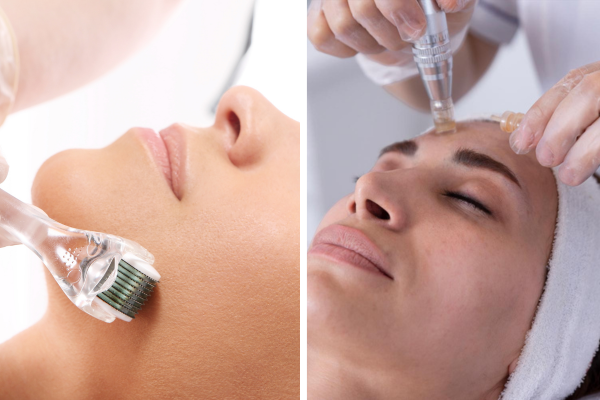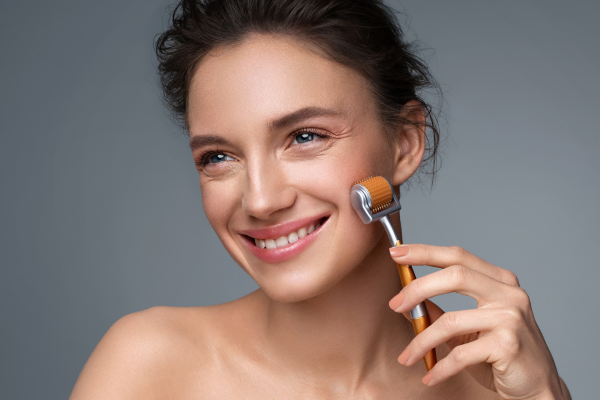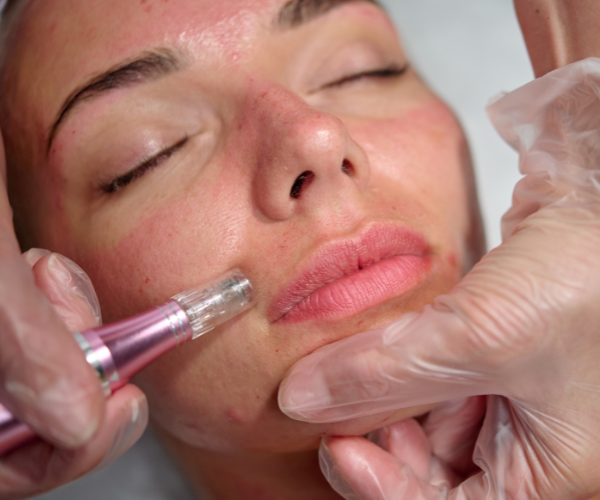
With the rise in the investment and adoption of skin rejuvenating treatments, microneedling ranks among the top collagen induction aesthetic treatments. This is because microneedling is minimally invasive and effective on wrinkles, fine lines, enlarged pores, stretch marks, uneven skin tone, and hyperpigmentation.
In addition to addressing over five skin concerns, there are at-home microneedling kits for convenience and privacy. So, your clients can perform a microneedling procedure in the comfort of their own homes. However, there are two kits you can recommend to your clients: derma roller or derma pen kits. So, which one shall it be?
To help you select a microneedling kit suitable for your clients, let’s take a look into the pros and cons of a derma roller vs derma pen. Keep reading to the end to discover the factors to consider when choosing a microneedling kit for professional or at-home use.
Derma Roller
A derma roller is a microneedling device with a handle and a cylindrical roller head attached at the end of the handle. Tiny needles are embedded on the surface of the cylindrical roller, with a length ranging from 0.25mm to 2.0mm. The number and arrangement of the needles varies, with some derma rollers allowing you to adjust the length of the needles as you use them.
As you roll a derma roller over the client’s skin, the needles on the cylindrical barrel puncture the skin’s outer layer (epidermis), reaching the deeper layer (dermis). This leaves micro-injuries on the client’s skin, stimulating the body’s natural healing.
During the healing process, the skin releases elastin and collagen, critical proteins for skin elasticity and structure.
Over the healing period, elastin and collagen production improves skin texture, reduces scars, and gets rid of fine lines, eventually rejuvenating the skin. That is why microneedling is referred to as a collagen induction aesthetic treatment.
Even though derma rollers can be used in a professional setting, they are mostly recommended for at-home use. Find out why in this comprehensive, in-depth look at the pros and cons of dermal rollers.
Derma Roller vs Derma Pen: Advantages of a Derma Roller

1. Cost-effective
- Derma rollers are generally cost-effective for both you (the professional) and your client. They are less costly due to:
- Low production cost
- Mass production
- Wide availability
Reusability.
From the structural design to production material, derma rollers are relatively simple devices. The cylindrical barrel and handle are primarily plastic, while the needles are medical-grade titanium or stainless steel. A combination of these parts makes production relatively inexpensive.
Besides being made from affordable parts, manufacturers mass-produce derma rollers as the demand for at-home use increases. Mass production leads to wide availability, as several brands and retailers strive to attract customers by offering affordable options.
Customers also enjoy the chance to reuse a derma roller for multiple treatments. Over time, this reduces the additional expenses the end user would incur if they wanted to incorporate microneedling into their skincare routine.
2. Suitable for at-home use
Overall, training or instructing a client on how to use a derma roller is relatively straightforward. One, a derma roller is manually operated, meaning the client does not have to worry about charging or replacing batteries as they do with a derma pen.
Two, a derma roller is affordable and versatile. It comes packed in a kit containing the derma roller, topical serum, introduction guide or manual, disinfectant solution, cleaning tools, a storage case, and other accessories.
Some do include a numbing cream to help reduce discomfort during treatment. Moreover, some dermal rollers allow the end user to configure the derma roller to use different needle lengths.
When should you recommend a derma roller?
Due to its compact and portable nature, you can recommend a dermal roller as an add-on alongside other cosmetic treatments like topical serums or creams and hyperpigmentation creams. Derma rolling enhances the absorption of the creams or serums, giving the clients the desired results.
While derma rolling can enhance product absorption, ensure that you provide your clients with a list of suitable products and direct them on what needle height to use. Needles with a height of 0.25mm to 0.5mm are recommended for product absorption enhancement. Longer needles might lead to skin tearing.
Remember to advise the client on the parts they can use the derma roller on. A derma roller is commonly used on the neck and face to address concerns like enlarged pores, wrinkles, and fine lines. Some use a derma roller on the scalp to stimulate hair growth.
It is crucial that the client avoids using a derma roller around the under-eye or buttocks, thighs, and stomach. This is because a derma roller is less precise and does not offer greater control.
Derma Roller vs Derma Pen: Disadvantages of a Derma Roller

1. Less precise and controlled microneedling
If both of you lack steady hands and derma rolling experience, you or your client are prone to errors. The rolling action requires one to maintain a consistent angle and pressure throughout the motion.
Overall, the derma roller’s manual mechanism makes it less precise and difficult to control, potentially resulting in uneven penetration. Moreover, the lack of control makes it difficult to address fine lines and acne scars in areas with less surface area, like the under-eye.
The circular roller head makes it difficult to maneuver around the contours of parts like the lips or eyes. So, one should avoid using a derma roller in these areas, as accidental contact may lead to injury.
2. Needles become dull or get damaged over time, reducing effectiveness
Whether a derma roller comes with fixed needles or replaceable ones, the needles eventually become damaged or dull. The major causes for this include improper storage, interaction with cleaning solutions, and repeated use.
Dull or damaged needles are more likely to cause injuries or infections. This is because they cannot evenly penetrate the skin as deep as they should. So, rather than gliding smoothly on the skin, they may tug or drag on it, causing unnecessary discomfort (injuries).
As the expert, show your clients how consistent maintenance enhances the safety and effectiveness of a derma roller. They should clean the device regularly and store it properly to avoid bacterial buildup.
In addition to regular roller cleaning, they should assess the device for damage or wear. To save them the hassle of using a potentially infectious derma roller, recommend a derma roller whose needles can be swapped out for new ones.
Due to needle wear and tear, derma rollers have a limited lifespan. Moreover, their structure is not that durable, meaning your client may have to replace their derma roller frequently for optimal results. So, how do all these compare to derma pens as an alternative microneedling device? Let’s find out.
Derma Pens

A derma pen is also a microneedling device, but it has advanced capabilities. Rather than a cylindrical roller head, the pen has a vibrating head that contains a cartridge housing multiple tiny needles. The needles are usually 0.25mm to 2.5mm long.
For a derma pen, you don’t have to worry about the amount of pressure to exert. It uses batteries to operate. When switched on, the needles oscillate rapidly on the skin’s surface, leaving micro-injuries just like a derma roller does. Then, the whole skin rejuvenation process takes place.
Compared to a derma roller, a derma pen allows you to customize it for precise penetration, making it suitable for varied skin areas. Let’s dive deep into the advantages of a derma pen and more.
Derma Roller vs Derma Pen: Advantages of a Derma Pen
1. Precise and suitable for targeted treatment
To achieve optimal precision, a dermal pen has an adjustable depth control feature. This means you, as the professional, can customize treatments for various clients based on their cosmetic concerns, skin type, or other factors.
With a dermal pen, you can precisely target delicate areas like the under-eye or lips. Moreover, if you are treating irregularly shaped or smaller areas of the face, it is pretty easy to solve problems around the areas with optimal accuracy.
2. Less risk of skin tearing
Unlike a derma roller, a derma pen’s needles penetrate the skin vertically. This means that rather than using lateral force as a result of the rolling motion of a derma roller, a derma pen pierces the skin directly, reducing potential trauma even to the most sensitive skin.
The vertical movement of the derma pen’s head is more consistent and controlled, reducing the likelihood of uneven friction or pressure on the skin. This reduces the risk of skin tearing or bruising.
3. Users experience less discomfort and fewer adverse effects
Both vertical needle movement and the adjustable depth control feature of a derma pen contribute to your client experiencing less discomfort. The oscillating or vibrating movement of the derma pen needles also reduces the chances of the client being uncomfortable.
Moreover, derma pens come with disposable sterile needle cartridges. This enhances hygiene and reduces the risk of adverse effects like inflammation and infections.
It would help if you used a new needle cartridge for each treatment session. Doing so would eliminate the possibility of cross-contamination and maintain optimal needle sharpness for consistent results. This would leave your clients more confident in your expertise.
Despite granting your client a better experience, a derma pen should mostly be used in a professional setting. Unfortunately, a derma pen is not suitable for at-home use. Keep exploring to discover why this is the case.
Derma Roller vs Derma Pen: Disadvantages of a Derma Pen

1. Requires more expertise and training
Before you can begin offering aesthetic treatment services using a derma pen, you must go through training. This is to ensure you can effectively and safely handle a derma pen.
The training includes mastering micro-needling techniques, understanding needle depth, following strict safety protocols, and more. These aspects of the training aim to minimize risks of complications and assure your clients optimal results.
During the training, you also learn how to critically assess the patient’s skin, apply the correct needle settings, and perform the procedure with skill and precision. That is why recommending a derma pen for home use is usually discouraged, as the client does not have the proper training to handle the device on their own.
2. It is costly compared to a derma roller
The advanced tech and precision mechanism built into a derma pen makes it costly. The motorized cartridge, electronic components, and ergonomic design make a derma pen more expensive compared to a derma roller.
Moreover, the need for training contributes to the overall cost and complexity of microneedling using a derma pen. Although a derma pen is expensive, you, as a professional, can also use a derma roller in various situations to cut on cost. Here are tips to help you choose the right microneedling tool.
Choosing the Right Microneedling Tool
1. Client’s skin concerns and desired outcomes
Different skin concerns call for either a derma pen or a derma roller. The two offer different levels of customization, depth control, and precision. For example, a derma pen may be more suitable for clearing wrinkles and fine lines than acne scars.
A derma roller has longer needles that can penetrate deeper into the skin, helping rejuvenate skin and eliminate acne scars. However, you should avoid using a derma roller on areas with open wounds, irritated skin, or active acne. The same goes for a derma pen.
You should be able to understand your client’s goals and tailor treatments accordingly.
2. Budget considerations
With help from the insights outlined in this article, you should be able to weigh the cost of a derma pen or roller against its capabilities and benefits. Remember to take into account factors like treatment efficacy, return on investment, long-term maintenance cost, and client satisfaction too!
Finally, Take Pride in Partnering with Yastrid, a Professional Medical Aesthetic Supplier
With over 16 years of experience manufacturing medical aesthetics products, Yastrid stands out as an exceptional supplier. The products are CE2292 AND ISO13485 approved to ensure quality results.
You also get a chance to try out a free sample for every order you make to assess the quality of the products. Give Yastrid’s microneedling pen a try today to enhance the radiance of your client’s skin.
